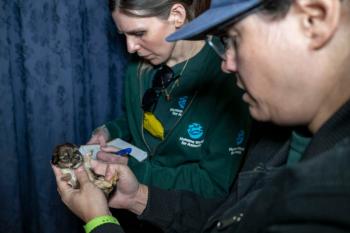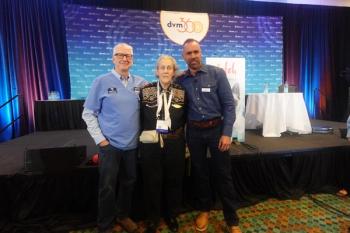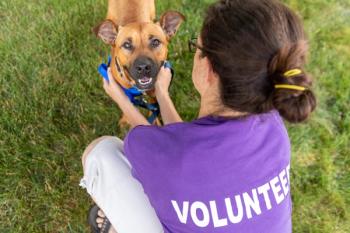
- Vetted January 2020
- Volume 115
- Issue 1
The home stretch: Practical care for geriatric pets and their owners
Dr. Mary Gardner believes that golden-age pets offer veterinary practices a golden opportunity to provide better care for their patients and more support for their patients families.
Mary Lynn Strand / stock.adobe.comVeterinarians have a variety of tools at their disposal to keep puppies and kittens healthy as they grow, and we are well prepared to help our patients as they reach their adult and senior years. What we don't always keep in mind is that caring for a geriatric pet is much different from caring for a younger animal. As pets enter the last life stage, there is much that can be done to keep them comfortable and help their owners deal not only with their fragile family member but also with the personal toll that providing care can take on them.
dvm360 spoke with
Life stages
dvm360: First things first. How do we distinguish senior and geriatric pets?
MG: Veterinarians cater to patients in four life stages: the puppy/kitten stage, the adult stage, the senior stage and the geriatric stage. Although we tend to link the senior and geriatric stages together, there are some big differences. A nine-year-old lab that comes in wagging its tail is considered a senior, but we think much differently about a wobbly 12-year-old lab.
When we think about the age of a pet in the geriatric stage, we have to consider the pet's size as that can determine the category. For example, think of a Great Dane that's 9 years old. That dog may be geriatric, but a smaller dog may not start to be considered geriatric until age 12 or older. In general, we might consider the last 10% to 15% of any pet's lifespan to be the geriatric stage, regardless of the animal's size. A cat's geriatric stage can be considered even later in life.
dvm360: What's so different about older pets?
MG: Geriatricians in human medicine deal with three major aspects of patient care: polypharmacy, dementia, and helping caregivers help their aged family members. In veterinary medicine, caregiver (client) education is one of the most important aspects of caring for our geriatric patients. In people, the difference between a senior and a geriatric is not their exact age but how fragile they are: A senior is usually thought of as 65. How that person acts or what physical abilities they may have don't come into play-it really is just a number. A person is considered geriatric when they are more susceptible to adverse outcomes and increased health risks-when they are fragile.
The golden opportunity
dvm360: Why is it so important for veterinary practices to educate their clients about caring for a geriatric pet?
MG: Better medicine, better nutrition and a stronger human-animal bond mean that veterinary practices today see more geriatric pets than ever. Data intelligence company VetSuccess worked with me to determine general practice demographics, and we found that only 5% of pets in the average clinic's database are in the puppy/kitten life stage. About 30% are adults, 15% are seniors and a whopping 48% are in the geriatric stage.
Similarly, the AVMA reported in 2007 that 30% of patients in an average veterinary practice are 6 to 10 years old and another 15% are over age 10. That's about 45% of your client base that's considered senior and geriatric.
If you apply those numbers to your practice, that's a lot of missed opportunity to help your patients and clients while generating additional revenue for your business. Yet we tend to concentrate our marketing efforts toward owners of puppies/kittens and adult pets. This is understandable as those pets have greater lifetime value to a practice. But pets that are in the geriatric stage are the ones that could benefit the most from seeing their veterinarian. So, keep in touch with those clients with senior and geriatric pets!
dvm360: Are most practices doing this now?
MG: Sadly, many aren't getting the chance. In the same VetSuccess study, 77% of cats over age 12 hadn't been seen by their veterinarian within the 18 months preceding a euthanasia. And the numbers are only slightly better for dogs: 69% of dogs 10 years and older hadn't been seen by their veterinarian within the 18 months preceding a euthanasia.
Practical care for pets and clients
dvm360: OK, so can you give us your best advice on how practices should concentrate their efforts?
MG: A home visit can be massively helpful when assisting a family with a plan to manage their geriatric pet. But for many veterinarians, that's just not feasible. Instead, ask families to bring in videos and pictures of the home environment to help you look for trouble spots, identify areas of opportunity or confirm that the family is doing a great job with their pet. It's also helpful to ask clients to fill out a questionnaire like
Mobility is the most common ailment we manage at Lap of Love, particularly with the larger breeds (but it does affect cats as well). In more than half of the homes I enter, the main living area is covered in tile flooring with no areas of traction. I call this the “ice rink of struggle” for dogs with mobility issues. You'd be amazed at what a simple “runway” of yoga mats or bathmats can do for a dog. Harnesses that can be worn at all times are also a great help. For tips on helpful products for managing pet mobility, click
Safety is paramount with these grey-muzzle pets. Think about stairs-even one or two can cause a tragic tumble. Consider pools or lakes, or areas where the pet could get into trouble. Also be wary of young children, who may not understand the concept of a pet in pain, dealing with decreased vision, etc.
dvm360: But you feel strongly that these owners need care, too.
MG: It wasn't until I dealt with the struggles of caring for my own geriatric pet that I fully appreciated the toll it placed on me. We love our pets, and we'll do what we need to do for them, but it's hard both physically and emotionally. We also have the burden of deciding the appropriate time for euthanasia. That in itself is a heart-wrenching decision and pet owners need our guidance.
dvm360: You wrote an article for dvm360.com two years ago about caregiver burden among pet owners. Can you tell us about that?
MG: Yes, it was a cross-sectional observational study and the first to examine the
The study results showed a greater level of caregiver burden and stress in the group caring for a sick pet; these individuals also had greater perceived stress levels and symptoms of depression and anxiety, as well as lower quality of life scores. These results aligned closely with those found in caregivers of human family members.
dvm360: What are the symptoms of pet caregiver burnout?
MG: Symptoms of caregiver burnout-regardless of whether a pet or a person is being cared for-include withdrawal from friends, family and other loved ones; loss of interest in activities previously enjoyed; feeling blue, irritable, hopeless and helpless; changes in appetite, weight or both; changes in sleep patterns; feelings of wanting to hurt yourself or the pet/person for whom you are caring; emotional and physical exhaustion; and getting sick more often.
We need to empathize with our clients' feeling of burden and find ways to support them through things like education, respite care and helping them find ways to manage their pet.
Dr. Gardner is a co-founder of Lap of Love Veterinary Hospice, a network of veterinarians around the country whose goal is to empower every owner to care for their geriatric pets. She is also co-editor and contributing author of the textbook
Articles in this issue
almost 6 years ago
CBD: Forget the legal issues—does it work in veterinary patients?almost 6 years ago
7 veterinary dentistry tips for general practitionersalmost 6 years ago
What veterinarians can learn from dentistsalmost 6 years ago
2019 Practice Manager of the Year: Jessica Molinaalmost 6 years ago
Is venting healthy?almost 6 years ago
No solid evidence behind all-natural parasite productsalmost 6 years ago
Why are so many veterinary grads financially illiterate?almost 6 years ago
Pet owners dont ignore your recommendations because they are bad peopleabout 6 years ago
Building a strong recommendation for a veterinary therapeutic dietNewsletter
From exam room tips to practice management insights, get trusted veterinary news delivered straight to your inbox—subscribe to dvm360.






